Censored and Military Postal History
World War II - Civil Censorship - British Empire - St Lucia
| Postalcensorship Home | FPHS | CCSG |
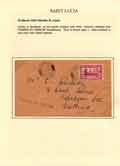 |
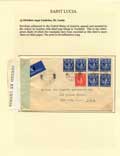 |
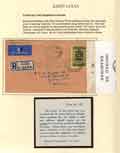 |
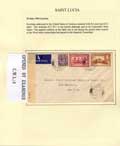 |
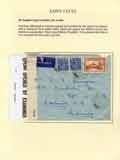 |
Published with permission & thanks to:
BCPSG, British Caribbean Philatelic Study Group
Extract from the June 2000 edition of British Caribbean Philatelic Journal:
World War II Civil Censorship in St. Lucia
by Edward T. Tweddell
Introduction
Data from over 350 censored items were used to produce the results of this present study. It is assumed that the items recorded form a representative sample of the mail censored in St. Lucia.
The usual abbreviations are used: Earliest Known Date (EKD) and Last Known Date (LKD) in the form DDMMYY. Illustrations of devices are shown fullsize and as accurately as possible. The notation (new) is used to indicate additions to devices that have been identified during the current study.
Censorship of Sealed Mail
Handstamp CH1 (Roses H1)
![]()
Figure 1. Handstamp CH1.
For the most part, the length, where given, is stated to be between 53mm and 56mm. However, all those that I have seen personally are about 54mm. The handstamp was used spasmodically throughout a period of 3? years. It was used only on envelopes. Four distinct periods have been identified as described in the following section.
First Period EKD: 7OC39. There is one report early in the war of a purple handstamp on a paquebot letter mailed at St. Lucia and addressed to Barbados.1 Its existence has been confirmed by the current owner. The envelope was not opened for examination.
Second Period EKD: 28JU41 LKD: 22MY42. In this second period, lasting almost a year, 28 further examples are recorded, all are in black, with the exception of three purple examples in February and March 1942. The two earliest examples appear on incoming mail; the remainder are on outgoing mail. None of the envelopes have been opened. During this period it was largely used as a secondary device to the earliest labels.
Third Period EKD: 21SP42 LKD: 26SP42. Two further black examples are recorded on unopened outgoing mail. These are the only censored items recorded in September 1942, a period when labels seem to have been unavailable.
Fourth Period EKD: 21MR43: LKD: 31MR43. There is a sudden glut of seven examples in ten days, one of which was incoming. The last four items have been opened and resealed with brown tape, with two of the handstamp impressions being purple. These were apparently used in an emergency between the LKD of the CL3 label and the lone example of CL10 label.
Label CL1 (Roses L1)
Text length 76mm
![]()
Figure 2. Handstamp CL1a.
First Period EKD: 30SP39 LKD: 16DE39. Like handstamp CH1, this label gets a brief airing in the early part of the war. Three outgoing items are recorded, the labels being white, green and blue/green.
Second Period EKD: 5DE40: LKD: 30DE41. There is a gap of almost one year before the label is re-introduced, a year during which no censored items have been recorded at all. The majority of the labels are white, the remainder being reported as various shades of green. The printing can be located at the top or bottom of the label.
The size of the label varies enormously, the length is between 80 and 92 mm, and the width generally between 30 and 41 mm. It seems clear that these were cut from sheets by hand using a guillotine, which explains the variation in the label size and the location of the text. There are 67 of this type, including the three early ones.
Label CL1b (new) Text length 74mm
EKD: 12FE42 LKD: 9MR42
Label CL1a (Roses L1a) Text length 68mm
EKD: 2AP42 LKD: 26NO42
Summary of the First Labels
CL2 (Roses L2)
EKD: 9JA43 LKD: 3FE43
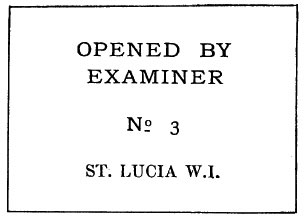
Figure 3. Label CL2.
Things were remedied, because the final three labels have the name cut or torn off. Numbers recorded are 1 to 4 inclusive. All examples are outgoing.
P.C. 90 Labels were the standard labels issued for re-sealing envelopes and come in many types, they are shown in Fig. 4 and in Fig. 5. Those in Fig. 4 are arranged to aid comparison between similar labels.
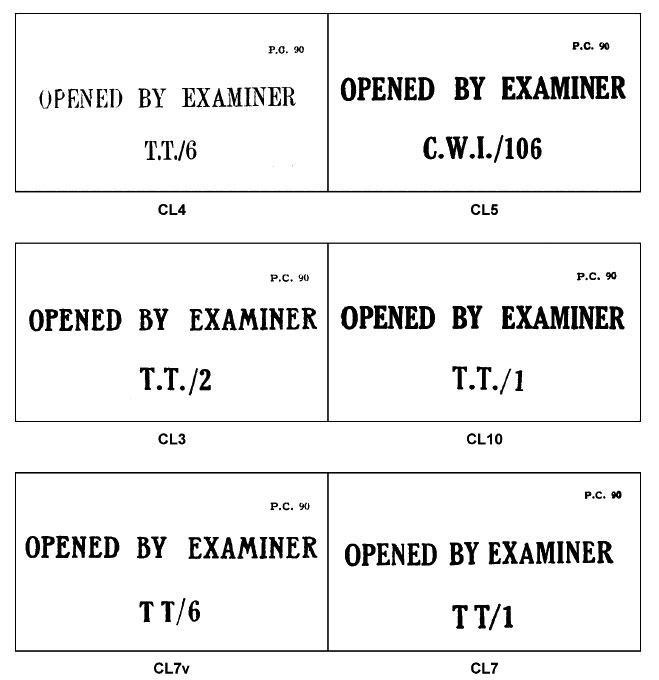
Figure 4. The Labels with Printed Censor Identifiers.
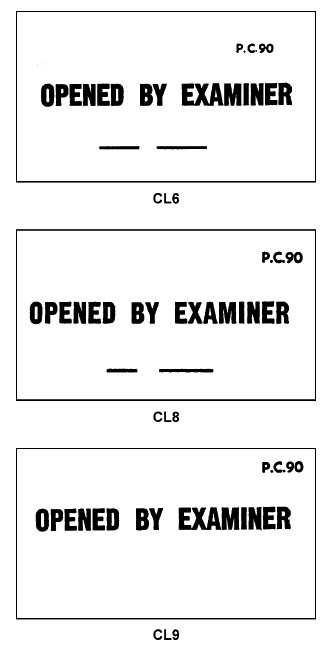
Figure 5. The "Universal" Labels.
Label CL3 (Roses L3)
EKD: 27FE43 LKD: 22MR43
Label CL10 (new)
EKD: 2AP43
Label CL4 (Roses L4)
Second Period EKD: 18AP45 LKD: ??AP45. Two examples are recorded in April 1945 on outgoing mail, both having the number 4. Each has the letter "I" for "Imperial" added in manuscript before the "T.T." (See Fig. 10.)
Label CL5 (Roses L5)
Large Numbers
EKD: 29AP43 LKD: 22MY43
The 1945 date recorded in Ref. 1 is in error that cover has been located and it is definitely 1943. One label shows a malformed letter "C", as shown in Fig. 6.
![]()
Figure 6. Examples of Label CL5 Censor Identifiers.
Small Numbers
EKD: 12JU43 LKD: 26AU43
Text Length 75mm. This is the first of three universal labels issued to many colonies in which there is no printed country code or number. Numbers recorded on this label are 1-14 inclusive. This label is slightly smaller than normal.
First period EKD: 18AU43 LKD: 31JA44. During this five month period, 52 examples are recorded. Two are incoming from neighbouring French islands. These have an added manuscript number of the form "TT/3."
Second period EKD: 4MY44 LKD: 6NO44. It was used much more sparingly in this six month period with only 12 examples recorded, including one arriving from Barbados. The manuscript addition is as above.
Third period: EKD: 11JA45 LKD: 17JA45. Only two examples are known, having the manuscript form "ITT/3."
Label CL7 (Roses L7)
Fig. 7 shows examples of major and repeated variations which have been reported in addition to the normal types: "TT/3" has a heavy number "3"; the spacing between the "T"s in "TT/4" varies; the first "T" in "TT/5" has a triple split at the bottom. In addition the slope of the stroke varies.
![]()
Figure 7. Examples of censor identifiers as seen on Label CL7.
The labels are all described variously as brownish or cream-coloured. The CL7/CL7a labels can be readily identified because, unlike CL3/CL10, there are no periods associated with the "TT" country indentifier.
First Period EKD: 4FE44 LKD: 24AU44. There are 37 examples recorded in this period, three incoming from the Caribbean. As described above, numbers recorded are 1-6 inclusive.
Second Period EKD: 27MR45 LKD: 12AP45. Four labels were used with a letter "I" added as a prefix to the censor code. These were used by censors 1, 4 and 6. Censor 4 actually used a label of censor 6 and amended it, as shown in Fig. 8.
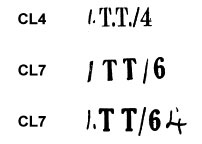
Figure 8. Labels amended for "Imperial" Censors.
Label CL7v (new)
EKD: 9FE44: LKD: 8JY44
The numbers recorded are 3, 4 and 6. I do not think that this is a separate printing given that these labels are distributed among the CL7 labels chronologically. See also Summary and Discussion.
Label CL8 (Roses L8) Text Length 78mm
EKD: 5SP44 LKD: 3AP45
Label CL9 (new) Text Length 73mm
EKD: 30AP45 LKD: 25JY45
Summary and Discussion
Table 1 shows the broad data for each of the devices discussed in this paperTable 1.
Censorship Device Summary
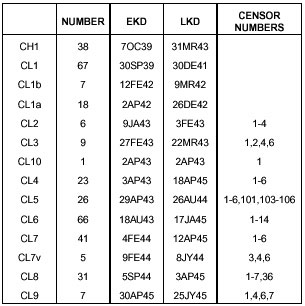
Fig. 9 displays the detail of usage over time.
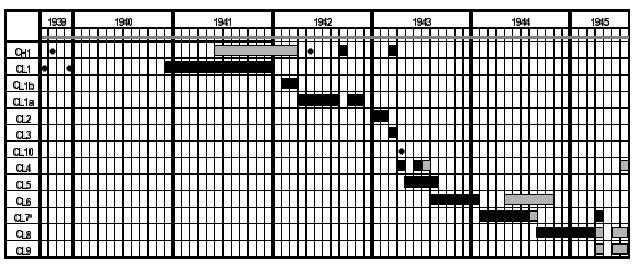
Figure 9. Chronology of censorship devices.
In Fig. 9, a solid black box indicates the principal censorship device, and a shaded box a period of subsidiary usage. Isolated instances are shown by a diamond. The row labelled CL7* combines the CL7 and CL7v data.
Handstamp CH1 was used primarily as a back-up device, except for short period when there seem to have been no labels available, when it became the principal device. Generally envelopes examined were not opened, except for the last four items recorded in 1943, when they were opened and resealed. It seems inexplicable that when virtually every other colony was opening envelopes and resealing them with brown tape, then applying a handstamp, St. Lucia did not do this.
Most of the labels follow one another sequentially, except for the universal labels CL6, CL8, and CL9, which are sometimes used as the principal device, but can also appear in conjunction with other labels.
The top part of labels CL10, CL5, CL7 appear to be identical, and similar labels are seen in Trinidad and other colonies. The top halves of labels CL3, CL7a are also identical, but are seen only in Trinidad.
The conclusion must be that these labels were printed in the same place, and that place was very likely Trinidad. I surmise that sheets of labels were mass produced with only the top half printed. These were stored and used for specific printing jobs as the need became available. This might explain the coexistence of CL7 and CL7v if some of the "wrong" sheets were mixed in, when the St. Lucia order for labels was filled.
Labels CL7 and, surprisingly, CL4, make a return at the very end of the censorship period, and are amended for use by Imperial censors. (See the section on Imperial Censorship).
The database includes 335 outgoing covers, 18 incoming covers, most of which occur in the last year of operation of the censorship office, and one paquebot cover in 1939.
The overriding impression one gets from this data is that St. Lucia was struggling for labels for much of the time.
Consider the CL1 labels printed on a mixture of white and green stock, the production of three labels (other than CL1), which are of a type completely unique to the island, the use of three different universal labels, and the frequent re-introduction of the CH1 handstamp during periods when labels were scarce or unavailable.
Rate of Censorship
Table 2 shows the number of items recorded for 4 month periods(e.g. J-A indicates January through April).
Table 2.
Number of Covers Censored

Just four items were examined in 1939, and no more until December 1940. The censorship office seems to have just closed down during this period, although the CH1 handstamp and the CL1 label were obviously available.
There is a reduction in the number of items censored in 1942, which may also be attributed to label shortages, especially in the last four months, when censorship dropped dramatically as supplies of label CL1a ran out; it seems likely that only selected items were censored during these periods.
With the introduction of the P.C. 90 labels in 1943, things settle down. The rate of censorship is fairly constant, and continued until July 1945. Fifteen of the last 18 items censored have a connection with non-British states, including France, Dutch colonies, Haiti and Argentina; ten of these are dated well after the end of the war.
The Other Handstamps
In addition to the labels described above, there are also three additional handstamps used for censored mail.These are described in the following sections and are shown in Fig. 10.

Figure 10. The Other Handstamps.
Handstamp CH2(Roses H2 )
EKD: 31JA44 LKD: 13AP45
Handstamp CH3 (new)
EKD: 11SP43
A very similar handstamp, but with the code letters "SS" has been recorded for Grenada5 on an item of consignee mail in 1944. The Grenada handstamp has a censor number included below the crown. The St. Lucia impression is not strong enough to say whether there is a number there or not, but one would expect there to be.
Handstamp CH4 (new)
The Censors
These six censors continue until September 1943, briefly adding 100 to their numbers, probably erroneously. From October 1943 until the end of that year, numbers 7-14 are added; these additional censors disappear in 1944. Later, number 7 appears on one label in December 1944 and on the last two items recorded, in July 1945. The surprising number 36 appears once, on a normal cover to the UK in April 1945.
When other British Caribbean colonies were involved in the introduction of a three digit numbering system in 1942 and 1943, St. Lucia seems to have been left out of this process, assuming the temporary addition of 100 to the censor numbers was unauthorised. In fact, the only other colony in the Leeward and Windward Islands not to have any three digit censor numbers is Dominica.7
There were periods of severe shortage of labels, but despite this, the overall rate of censorship with six or seven censors for the most part, was quite good when compared with other colonies.
Imperial Status
Conclusion
- Handstamp CH1 is in use for 31/2 years before mail having this device finally begins to be opened.
- The censorship office was virtually closed for the whole of 1940.
- The short-lived locally produced label CL2 was used with the name of the colony included, before the instruction came to remove it.
- Censor numbers were introduced very late.
- The erroneous use of three digit numbers on label CL5, before the reversion to single digit numbers (how labels using the identifier "C.W.I." could have been escaped scrutiny remains a mystery, especially when they were probably printed in Trinidad).
An Enclosed Label
CLBL1 EKD: 3FE43
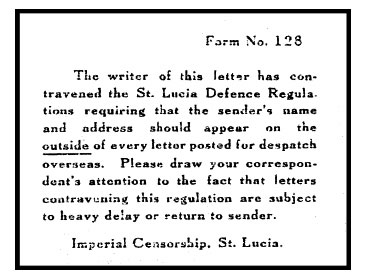
Figure 11. An enclosed label.
Acknowledgements I would like in particular to thank John Gardner, the leader of the St. Lucia study group of the BCPSG, who provided detailed information on his vast collection of almost 200 censored St. Lucia covers, and with whom I have had a detailed correspondence on this subject. The following members also provided valuable data, photocopies, and supplementary information: David Druett, Charles Freeland, Barry Friedman, Guy Kilburn, Derek Lilley, John Little, Mike Mead, Tom McMahon, Chris Miller, and Bill Tatham.
References
- Ritchie, G. G., West Indian Censorship Devices in World War II, Handbook No.1, Roses Caribbean Philatelic Society, 1976, pp. 65-70; West Indian Censorship Devices, Handbook No.2, 1977, p 55.
- Ritchie, G.G, St. Lucia: A Philatelic History, Roses Caribbean Philatelic Society, 1976, pp, 106-110.
- Wike, R.G., British Empire Civil Censorship Devices World War II: Trinidad & Tobago, Chavril Press, 1993.
- Torrance, A.R. and Morenweiser, K., British Empire Civil Censorship Devices WWII, United Kingdom, Civil Censorship Study Group, 1991.
- Cronin, J.A. and Walker, W.D., "Civil Censorship in Grenada, B.W.I.," CCSG Bulletin, August 1979, pp 82-85.
- Mayo, D., "A Trinidad Handstamp Previously Ascribed to the US," CCSG Bulletin, February 1987, pp 43-44.
- Ashley, W., "Dominica's WWII Censors Revisited," CCSG Bulletin, January 1994, pp37-41.
Updated: 4 October 2005
Copyright © BCPSG & Edward T. Tweddell
1999-2005 Webmaster